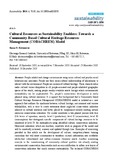Cultural resources as sustainabilty enablers: Community-Based Cultural Heritage Resources Management (COBACHREM) model

View/
Date
2013-12-20Author
Keitumetse, Susan O.
Publisher
MDPI, http://www.mdpi.comRights
Open accessRights holder
Author copyright, Susan KeitumetseType
Published ArticleMetadata
Show full item recordAbstract
People inhabit and change environments using socio-cultural and psycho-social behaviors and processes. People use their socio-cultural understanding of phenomena to interact with the environment. People are carriers of cultural heritage. These characteristics make cultural values ubiquitous in all people-accessed and people-inhabited geographic spaces of the world, making people readily available assets through which environmental sustainability can be implemented. Yet, people’s conservation development is rarely planned using cultural resources. It is against this background that a Community-Based Cultural Heritage Resources Management (COBACHREM) model is initiated as a new approach that outlines the symbiosis between cultural heritage, environment and various stakeholders, with a view to create awareness about neglected conservation indicators inherent in cultural resources and better placed to complement already existing natural resources conservation indicators. The model constitutes a two-phased process with four (04) levels of operation, namely: level I (production); level II (reproduction); level III (consumption) that distinguish specific components of cultural heritage resources to be monitored at level IV for sustainability using identified cultural conservation indicators. Monitored indicators, which are limitless, constitute work in progress of the model and will be constantly reviewed, renewed and updated through time. Examples of monitoring provided in this article are the development of cultural competency-based training curriculum that will assist communities to transform cultural information into certifiable intellectual (educational) and culture-economic (tourism) assets. Another monitoring example is the mainstreaming of community cultural qualities into already existing environmental conservation frameworks such as eco-certification to infuse new layers of conservation indicators that enrich resource sustainability. The technical COBACHREM model acknowledges existing academic frameworks of communal identity formation (e.g., indigenity and autochthony) and is designed to add value onto these.
Collections
- Research articles (ORI) [270]
Related items
Showing items related by title, author, creator and subject.
-
Strategies for infusing cultural element in product design
Moalosi, R.; Popovic, V.; Hickling-Hudson, A. (Design Education Forum of South Africa (DEFSA), http://www.defsa.org.za, 2007-01-01)There is little in-depth research that can assist designers to use culture as a catalyst for designing innovative products within Botswana’s context. This is supported by evidence from the literature which indicate that ... -
Strategies for infusing cultural elements in product design
Moalosi, R.; Popovic, V.; Hickling-Hudson, A.R. (Design Education Forum of South Africa (DEFSA) http://www.defsa.org.za, 2007)There is little in-depth research that can assist designers to use culture as a catalyst for designing innovative products within Botswana’s context. This is supported by evidence from the literature which indicate that ... -
Culture-orientated product design
Moalosi, R.; Popovic, V.; Hickling-Hudson, A.R. (Springer http://www.springerlink.com/index/4p70461149163718.pdf, 2010)There is little in-depth research that can assist designers to use culture as a catalyst for designing innovative products within Botswana’s context. The concept of culture and design are intertwined, thus modifications ...
